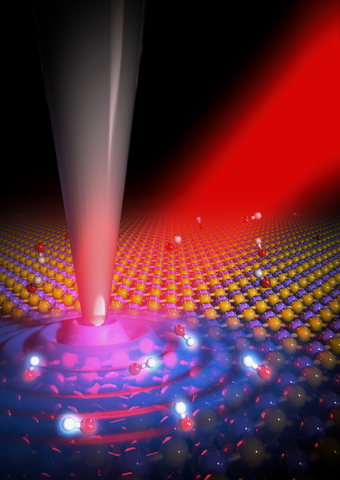Nov 24 2020
Scientists from CIC nanoGUNE BRTA (San Sebastian, Spain), together with the Donostia International Physics Center (San Sebastián, Spain) and the University of Oviedo (Spain), applied a spectroscopic nanoimaging method to explore the interaction between infrared nanolight—in the form of phonon polaritons—and molecular vibrations.
 Illustration of nanoimaging of molecule vibrations coupled to phonon polaritons (blue wave) in a thin boron nitride layer. Image Credit: Scixel. Copyright: CIC nanoGUNE BRTA.
Illustration of nanoimaging of molecule vibrations coupled to phonon polaritons (blue wave) in a thin boron nitride layer. Image Credit: Scixel. Copyright: CIC nanoGUNE BRTA.
The images show that strong vibrational coupling can be realized, a phenomenon that has recently gained a lot of attention for its probable use in regulating fundamental physical and chemical material properties.
The result could pave the way to the development of a unique platform for on-chip chemical identification of minute amounts of molecules and for exploring fundamental characteristics of robust coupling occurrences on the nanoscale. Details of the study have been reported in Nature Photonics.
Light has a vital role to play in contemporary science and technology, with applications spanning from fast optical communication to laser surgery and medical diagnosis. In a number of these applications, how light interacts with matter is of fundamental significance.
At infrared frequencies, light can interact with molecules through their vibrations that happen at molecule-specific frequencies. Therefore, molecular materials can be recognized by measuring their transmission spectra or infrared reflection. This method, regularly referred to as infrared fingerprint spectroscopy, is generally used for the examination of chemical, biological, and medical substances.
In recent times, it was discovered that the interaction between infrared light and molecular vibrations can be so powerful that ultimately the material properties, such as chemical reactivity and conductivity, are altered. This effect—known as vibrational strong coupling—can happen when a material is put into a microcavity (usually formed by mirrors that are divided by micrometer-sized distances), wherein the light is concentrated.
The strength of the interaction between matter and light relies more on the quantity of matter. Therefore, the interaction declines when the number of molecules decreases, challenging infrared spectroscopy applications and ultimately preventing robust vibrational coupling from being realized. This issue can be handled by focusing light in nanocavities or by compressing its wavelength, which results in light confinement.
A particularly strong compression of infrared light can be achieved by coupling it to lattice vibrations (phonons) of thin layers of high-quality polar crystals. This coupling leads to the formation of infrared waves—so-called phonon polaritons—that propagate along the crystal layer with a wavelength that can be more than ten times smaller than that of the corresponding light wave in free space.
Andrei Bylinkin, Study First Author, CIC nanoGUNE BRTA
Currently, the team has investigated the coupling between molecule vibrations and propagating phonon polaritons. First, they positioned a thin layer of hexagonal boron nitride (>100 nm thick) on top of organic molecules. Hexagonal boron nitride is a van der Waals crystal from which thin high-quality layers can be effortlessly acquired by exfoliation. Subsequently, it was essential to produce phonon polaritons in the thin boron nitride layer.
This cannot be achieved by just shining infrared light onto the boron nitride layer, because the momentum of light is much smaller than the momentum of the phonon polaritons.
Andrei Bylinkin, Study First Author, CIC nanoGUNE BRTA
The issue of momentum mismatch was sorted by using the sharp metal tip of a scanning near-field microscope, which serves as an antenna for infrared light and focuses it to a nanoscale infrared spot at the tip apex that delivers the essential momentum to produce phonon polaritons. The microscope also plays another vital role.
It allowed us for imaging the phonon polaritons that propagate along the boron nitride while interacting with the nearby organic molecules. That way we could observe in real space how the phonon polaritons couple with the molecular vibrations, thereby forming hybrid polaritons.
Rainer Hillenbrand, Study Lead, CIC nanoGUNE BRTA
The set of images captured at different infrared frequencies around the resonance of the molecular vibrations exposed a number of fundamental characteristics. The hybrid polaritons are robustly attenuated at the frequency of the molecular vibration, which could be useful for on-chip sensing applications in the future.
The spectrally resolved images also revealed that the waves spread with negative group velocity, and most significantly, that the coupling between the phonon polaritons and the molecular vibrations is so robust that it falls into the regime of vibrational strong coupling.
“With the help of electromagnetic calculations we could confirm our experimental results, and further predict that strong coupling should be possible even between few atom thick layers of boron nitride and molecules,” says Alexey Nikitin.
The likelihood of vibrational strong coupling on the extreme nanoscale could be applied in the future to create ultrasensitive spectroscopy devices or to explore quantum features of vibrational strong coupling that have not been possible thus far.
Journal Reference:
Bylinkin, A., et al. (2020) Real-space observation of vibrational strong coupling between propagating phonon polaritons and organic molecules. Nature Photonics. doi.org/10.1038/s41566-020-00725-3.